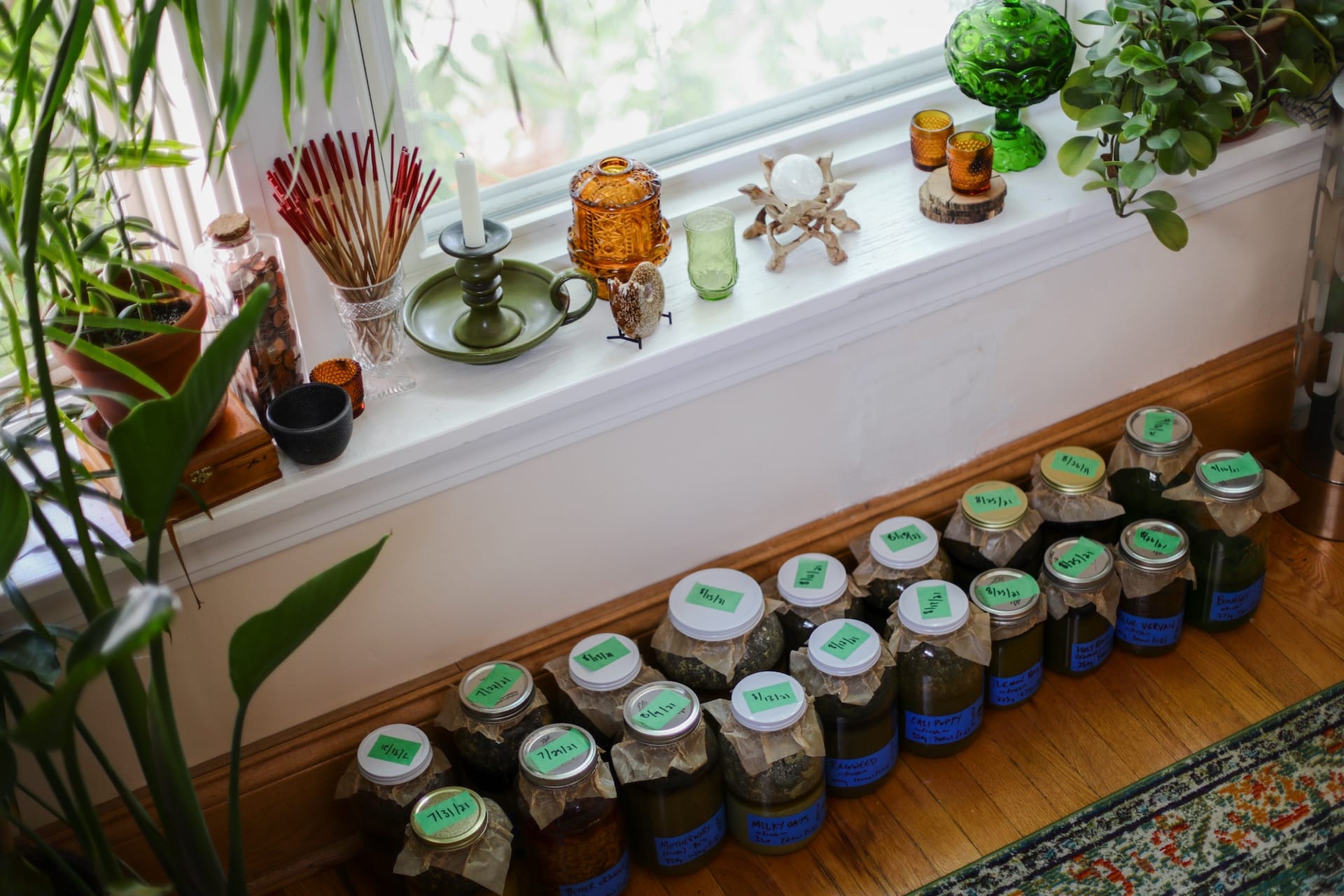Forager's Bitters: a not-so-simple recipe for reconnecting with our home-place

As a community herbalist, it is my goal to make herbalism accessible and approachable. So when I offer recipes for everyday herbal concoctions, I try to make them nice and simple for folks to follow along. I want to see as many people as possible jump right into the process, making messes of their kitchens in order to get a feel for how they might integrate folk herbcraft into their everyday rituals, supporting their health and the well being of their family and community along the way.
But sometimes, in order to really grow, in order to really transform... we need a bit of a challenge. Like a buried acorn, if we want to become an oak, we need to first find our way through the dark of the soil.
In the spirit of challenge, you might consider this more of a 'scavenger hunt' than a recipe in the traditional sense. Or like a map, leading you out into the native ecosystems of the Chicago region to make contact with the more-than-human realm and build relationships with the plants and mushrooms you find there.
This recipe is about the journey, not the destination... and in many ways this bitters blend reflects the journey of my transformation from an aspiring academic trodding a straight and narrow path–to the rascal of an herbalist I discovered myself to be, wandering around the woods and making potions instead.
It was after years of studying herbalism from amazing teachers and learning about the local ecology of the Great Lakes basin through my excursions in the woods, wetlands, and prairies, that I could look up at my apothecary shelves–stocked with hundreds of amber brown bottles, each filled with some botanical or fungal extract–and be reminded of how each has their own story of how they grew and how, in many instances, I became a part of their story when I asked them if it might be okay to gather them so they may be crafted into the medicines that would eventually nurture the well-being of my community.
On one occasion, in a particularly playful mood, I looked up at these very shelves, and found my hands were drawn to the herbal extracts that comprise the bitters blend offered below.
So I offer this bitters blend in the hopes that you may also saunter off whatever straight and narrow path you may be walking to stumble into the forests and fields of our beautiful bioregion where you may experience the wild abundance of medicine growing right beneath your very feet.
Forager's Bitters Recipe
Like I said, this blend is about the journey, not the destination... but the destination ain't too bad either ;)
The blend itself is a woodsy, earthy, and aromatic bitters blend that would do well in cocktails with aged spirits like whiskey or rum, and especially in stirred cocktails like an old fashioned or manhattan.
You can also throw a few squeezes into some bubbly water with a little lemon and maybe even some of that leftover shagbark hickory syrup you made.
Here is the bare bones recipe, but there are several different approaches which I'll outline below:
- Wild Cherry Bark (Prunus serotina) - 2 parts
- Reishi Mushroom (Ganoderma tsugae) - 2 parts
- Hawthorn Berry (Crataegus spp.) - 2 parts
- Black Walnut Hull (Juglans nigra) - 1 part
- New England Aster (Symphyotrichum novae-angliae) - 1 part
- Dandelion Root (Taraxacum officinale) - 1 part
- Spicebush Berry (Lindera benzoin) - 0.5 parts
- Shagbark Hickory Syrup (Carya ovata) - 0.5 parts
First, the 'parts' are a starting point, feel free to tweak as your taste buds desire. Also, you might have noticed that the plants and mushrooms that make up this blend can all be found growing in the Chicago region. Most are native to this region. Some are non-native but naturalized. My promise is that as you find and build relationships with these plants, your curiosity will blossom and spill out into other aspects of the ecosystem you are exploring, you will know more about the place you live, and consequently, you will know more about yourself.
There are two general approaches for making this bitters blend:
- Combine all the herbs together in a single jar, cover with high proof (75%) alcohol, put an air-tight lid on the jar and let it steep for 2 weeks, shaking every once in a while, and then strain.
- In this case you would measure herbs by weight and then pour just enough alcohol in the jar to cover the herbs completely, then add the shagbark hickory syrup in after you strain.
- Make separate extracts (tinctures) of each herb and then blend them later.
- In this case you would measure the herbal extracts of each herb individually by volume (ml or ounces) and blend all together in a larger vessel.
I prefer making separate extracts for a few reasons:
- If you want to combine in a single jar, you'd need to dry each herb upon harvesting to store until you have gathered all of the different herbs.
- You have less control of the flavor of the blend, because all the herbs are steeping together and some extract at different rates.
- By making separate extracts you can tincture herbs fresh as you harvest them, and once you tincture them, they store indefinitely.
- You will also be slowly building a botanical extract library (aka 'apothecary') that you can play with for years to come!
- Once you have all your single extracts you can combine them in any way you like and even combine with other tinctures you find yourself making along the way.
A few helpful articles that will help you out along the way:
- How to Make Herbal Tinctures – this article provides detailed instructions for preparing each of the extracts that will go into blending the final bitters blend
- Check out the Botany Basics course for an intro on basic plant identification
- Toxic, poisonous, and deadly plants & fungi you should definitely know before you go out foraging – speaks for itself!
- Foraging Tips + Tools
- Urban Foraging Guide
Some final thoughts and recommendations before you embark
While you can purchase some of these herbs through herbal suppliers and herb farms, I highly recommend you gather all of these herbs yourself.
In the Chicago Region, you are not legally allowed to harvest from Cook County Forest Preserves, and I don't encourage it either. You should definitely volunteer with one of the stewardship groups at a forest preserve near you which might give you a better idea of why this might be the case.
You can check out some of the state parks around the Chicago region, many of which you can forage from in small quantities for personal use (as long as you are not harvesting at-risk or endangered species like Trillium or Goldenseal).
Don't expect to go out one day and gather all of these herbs in one foray. The plant parts utilized in this blend emerge in different seasons, and the plants themselves grow in different ecosystems. Some of these plants may be growing right outside your front door in the middle of the city (like Dandelion and Hawthorn–although I wouldn't harvest a dandelion root from a city lot, I would, however, harvest hawthorn berry from a tree growing in a city parkway–see this post for guidelines on foraging in the city and beyond), some you may be able to grow in your back yard (New England Aster, Spicebush). Some, you might need to go further out to find.
Perhaps this blend takes you several years to make, because you begin by just going out and building relationship with the ecosystems these plants grow in. Once you've learned to identify the plants and mushrooms in this blend, you've probably learned a lot of other plants and mushrooms along the way, and at this point you've given more time and consideration to how you may forage each plant sustainably and with minimal impact to the ecosystem that they grow in.
Maybe you end up with an entirely different blend because you fell in love with other plants and mushrooms that you found, and your growing apothecary skewed in another direction. Forager's Bitters can be any combination of herbs drawn from the relationships you build throughout this journey. My hope is that this recipe will nudge you off the path a bit so you can get lost (or found depending on how you look at it) in the woods, oak savannas, wetlands, and prairies that make our home a place worth rooting deeply into.


Member discussion